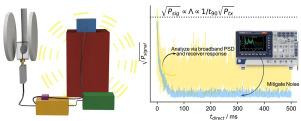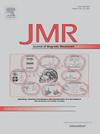Separate and detailed characterization of signal and noise at low resonance frequencies
IF 1.9
3区 化学
Q3 BIOCHEMICAL RESEARCH METHODS
引用次数: 0
Abstract
When developing or deploying a Nuclear Magnetic Resonance (NMR) spectrometer, especially for Overhauser Dynamic Nuclear Polarization (ODNP) or other experiments that require low-volume low-field measurements, the ability to mitigate noise and to quantitatively predict signal amplitude prove crucial. A quantitative treatment allows separate analysis of signal and noise and independent optimization of each. In particular, the results here emphasize that clarity and insight come from (1) characterizing the spectral distribution of the noise, and (2) integrating elements of theory and notation originally developed for Electron Spin Resonance (ESR) spectroscopy. Specifically, the spectral noise density “fingerprint spectrum” identifies sources of electromagnetic interference (EMI) and definitively confirms which actions do and do not mitigate the EMI, while the quantitative ratio () of to the square root of the power on the transmission line provides a useful focal point that simplifies the prediction of signal intensity and that decomposes into a few simple but exact factors. Thus, this article provides a relatively comprehensive overview of signal and noise in low-field NMR instruments. The protocol/toolkit introduced here should apply to a wide range of instruments, and give most spectroscopists the freedom to systematically design sensitive NMR hardware even in cases where it must be integrated with multiple other hardware modules (e.g., an existing ESR system), or where other requirements constrain the design of the NMR hardware. It enables a systematic approach to instrument design and optimization. For the specific X-band ODNP design demonstrated here (and utilized in other laboratories), it facilitates a reduction of the noise power by more than an order of magnitude, and accurately predicts the signal amplitude from measurements of the nutation frequency. Finally, it introduces reasoning to exactly determine the field distribution factor (, essentially, a more specific definition of the filling factor) experimentally from and thus identifies the inefficient distribution of fields in the hairpin loop probe as the main remaining bottleneck for the improvement of low-field, low-volume ODNP signal-to-noise ratio (SNR).

分离和详细表征信号和噪声在低共振频率
在开发或部署核磁共振(NMR)光谱仪时,特别是对于需要小体积低场测量的Overhauser动态核极化(ODNP)或其他实验,减轻噪声和定量预测信号幅度的能力至关重要。定量处理允许信号和噪声的独立分析和各自的独立优化。特别是,这里的结果强调了清晰度和洞察力来自(1)表征噪声的光谱分布,以及(2)整合最初为电子自旋共振(ESR)光谱开发的理论和符号元素。具体来说,频谱噪声密度“指纹频谱”识别电磁干扰(EMI)的来源,并明确确认哪些行为会减轻EMI,哪些不会减轻EMI,而B1与传传线上功率的平方根的定量比(Λ)提供了一个有用的焦点,简化了信号强度的预测,并分解为几个简单但精确的因素。因此,本文对低场核磁共振仪器中的信号和噪声进行了较为全面的概述。这里介绍的协议/工具包应该适用于广泛的仪器,并给予大多数光谱学家系统地设计敏感核磁共振硬件的自由,即使在它必须与多个其他硬件模块集成的情况下(例如,现有的ESR系统),或者在其他要求限制核磁共振硬件设计的情况下。它使仪器设计和优化的系统方法。对于这里演示的特定x波段ODNP设计(并在其他实验室中使用),它有助于将噪声功率降低一个数量级以上,并从章动频率的测量中准确预测信号幅度。最后,引入推理,从Λ实验中精确确定场分布因子(η′,本质上是填充因子的更具体定义),从而确定发卡环探针中场的低效分布是提高低场,小体积ODNP信噪比(SNR)的主要瓶颈。
本文章由计算机程序翻译,如有差异,请以英文原文为准。
求助全文
约1分钟内获得全文
求助全文
来源期刊
CiteScore
3.80
自引率
13.60%
发文量
150
审稿时长
69 days
期刊介绍:
The Journal of Magnetic Resonance presents original technical and scientific papers in all aspects of magnetic resonance, including nuclear magnetic resonance spectroscopy (NMR) of solids and liquids, electron spin/paramagnetic resonance (EPR), in vivo magnetic resonance imaging (MRI) and spectroscopy (MRS), nuclear quadrupole resonance (NQR) and magnetic resonance phenomena at nearly zero fields or in combination with optics. The Journal''s main aims include deepening the physical principles underlying all these spectroscopies, publishing significant theoretical and experimental results leading to spectral and spatial progress in these areas, and opening new MR-based applications in chemistry, biology and medicine. The Journal also seeks descriptions of novel apparatuses, new experimental protocols, and new procedures of data analysis and interpretation - including computational and quantum-mechanical methods - capable of advancing MR spectroscopy and imaging.

 求助内容:
求助内容: 应助结果提醒方式:
应助结果提醒方式:


